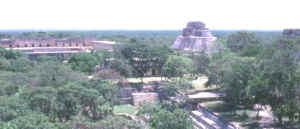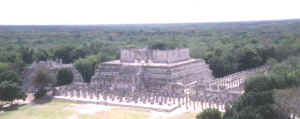
Featureless horizon as seen from Uxmal
Mayan site, Yucatan.
Chicxulub Meteorite Impact Crater
Although most of this crater is located beneath the waters of the Gulf of Mexico, a portion of this crater is located on the northwestern part of the Yucatan Peninsula of Mexico. Formed at the Cretaceous/Tertiary (K/T) boundary, approximately 64 million years ago, the impact that formed the crater is thought to have been responsible for the extinction of the dinosaurs. Presently buried beneath approximately one kilometer (1000 meters) of limestone, the crater has no direct surface expression.
(click on images to enlarge)

Featureless horizon as seen from Uxmal
Mayan site, Yucatan.

Featureless horizon as seen from Chichen Itza
Mayan site, Yucatan.
The limestone which forms the Yucatan Peninsula is essentially horizontal. In spite of the roughly 36-inch rainfall (approximately one meter) across the region, there are no surface streams on the peninsula. The rain water drains to the sea within the soluble bedrock through a series of interconnected caverns and caves. In some areas there are cenotes, which are water-filled sinkholes. The cenotes were used by the Maya as water sources for their cities, which were abandoned prior to the arrival of the Spanish and are now being restored.